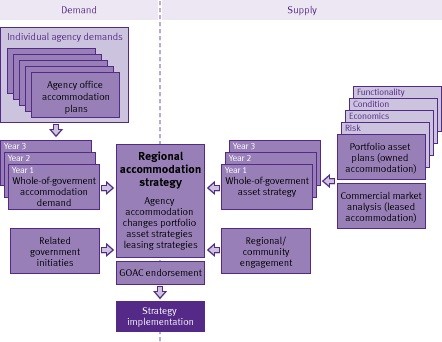Whole-of-government office accommodation strategies are developed, on a rolling basis, for the Brisbane CBD and 18 Queensland regional centres. These strategies are referred to as Office Accommodation Centre Strategies (strategies).
The strategically-significant regional centres, in government office accommodation terms, are Cairns, Townsville, Rockhampton, Mt Isa, Mackay, Emerald, Gladstone, Bundaberg, Maryborough, Hervey Bay, Sunshine Coast, Toowoomba, Ipswich, Caboolture/Morayfield, Gold Coast, Beenleigh, Mt Gravatt and Chermside.
The aim of these strategies is to provide better-value office accommodation by integrating the accommodation needs of each agency into a whole-of-government accommodation solution for each centre.
The benefits of adopting this approach include:
- improved purchasing power for government when negotiating in the private sector
- a cohesive approach to commercial development in regional centres
- scope to share common accommodation facilities and functions by agencies, resulting in lower recurrent costs for accommodation and collocating, where possible, Agencies with similar security requirements (in accordance with the Government Agency Preparedness arrangements)
- enhanced service delivery and easier accessibility for the public to government services resulting from strategies such as clustering like agencies and integrating customer service areas
- enabling agencies to identify and realise asset opportunities that otherwise might not have been considered
- maximised use of suitable government-owned accommodation in preference to acquiring additional commercial leases for office space.
The objectives of the strategies are to:
- provide appropriate and cost-effective office accommodation that meets the service-delivery needs of agencies
- align government office accommodation with broader government strategies for regional development across Queensland
- support government initiatives such as Access Queensland.
The scope of the strategies includes:
- assessing current and projected demand for all government office accommodation, including any office space owned or managed by departments other than EPW
- analysing the local commercial office property market
- developing options for private sector leasing and/or the acquisition, refurbishment or disposal of government owned premises
- assessing regional planning implications
- assessing the supply of all government office space, including office space owned and managed by departments other than EPW.
Other centres identified in the South East Queensland (SEQ) Regional Plan as principal or major activity centres, or as potential transit orientated developments, will be monitored to ensure that government office accommodation in this region complements the growth pattern established in the SEQ Regional Plan.
This strategic planning process is highly consultative and interactive to produce plans which meet:
- the time, cost and functionality needs of all agencies in each centre
- government policy and guideline requirements.
The expectations of the local property markets are addressed as part of the strategic portfolio planning for government-owned office buildings in each centre.
Building asset planning, on both strategic and operational levels, is undertaken by the department and incorporates best-practice management of the government's portfolio of office building assets in the context of supporting the delivery of agencies' services. The government's office buildings are performance-optimised specifically to support the delivery of government services by balancing functionality, value, return and risk rather than managed as an investment portfolio solely for maximum return on investment. Community obligations and expectations must also be considered in the portfolio's management, particularly in relation to heritage-listed buildings.
Strategic portfolio planning involves analysing each building in 4 categories of performance. These are:
- functionality
- physical condition
- financial performance
- risk.
Office buildings which are assessed as unsuitable and underperforming, and which are considered uneconomical to improve, are identified for disposal in a timeframe that:
- best suits the overall strategic planning process without adversely affecting agencies' office accommodation needs
- achieves the highest and best price.
Based on the outcomes of the above strategic planning process, and using agencies' demand input, capital investment decisions are made on new building acquisitions (construction or purchase), extensions to existing buildings, and building upgrading/refurbishment.
Strategies for the Brisbane CBD and 18 strategically-significant regional centres involve both accommodation strategic planning and building asset strategic planning.
Each strategy incorporates a master plan that:
- identifies unsuitable government office buildings for disposal
- confirms the suitability of existing government office buildings and/or the extent of refurbishment required
- addresses regional planning frameworks and implications
- analyses the local property market and identifies leasing opportunities and constraints
- establishes additional or reduced office accommodation demand forecasts and timeframes
- establishes the preferred option for acquiring additional office accommodation or reducing space
- maximises the use of government office buildings
- establishes a master program of linked projects to implement the master plan
- establishes project budgets and identifies funding
- satisfies the office accommodation needs of all agencies in that centre
- maximises whole-of-government benefits.
The components identified above establish a demand-and-supply model for government office accommodation as shown below.

View a larger version of the above regional accommodation strategies - supply and demand factors (PDF, 399.9 KB)
(If you can't view the information on this graphic, please email the Queensland Government Accommodation Office at qgao.enquiries@epw.qld.gov.au for more information.)



